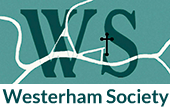In the early 1900s, Westerham boasted no fewer than eight independent butchers happily trading alongside each other around the town. In Quebec Square, William Dove traded as a pork butcher, Aberdeen House, to the right of the Pheasantry was the province of Master Butcher Edward Skinner; at the top of The Green next to the Grasshopper pub was the Co-Op’s butchery and today’s number 19 High Street, to the right of the Kings Arms was Charles Levett’s ‘Home and Colonial Meat Stores’. Larratt’s butchers of today was William Inglefield, while Thomas Townsend, a butcher and baker originally trading from the corner of New Street, had moved to today’s ‘Grace Hair Design’ – premises that would remain in the butchery trade for another eighty-five years. Last but not least was the London Meat Supply Company at ‘Roseville’, now a domestic residence between Squerryes Mead and Verrall’s Corner at the west-end of the High Street.
In 1916 Albert Boddy was the butcher of the day where Larratt & Co now trades. He placed an advertisement in the Westerham Herald newspaper for Saturday December 16 1916:
Weight-guessing Competition
Mr Albert Boddy’s contribution to the Xmas Dinner for our wounded at Dunsdale Hospital is a fine turkey, which can now be seen alive on his premises in the High Street. In order to raise funds sufficient to purchase as many more turkeys as they require, a weight-guessing competition will be held. Tickets are sixpence each, and a prize of Ten Shillings will be given to the person guessing the turkey’s correct weight when killed and dressed. Purchasers of tickets must fill in their name and address, with their guess, and return tickets to Mr. A. Boddy by one o’clock on Wednesday next. No tickets will be received later, and no tickets will be personally collected from purchasers. They must be deposited in a box on the premises. Competitors may cut out the coupon attached, or send as many guesses as they like on a signed sheet of paper, but every guess must be accompanied by sixpence.
Sadly, there was no follow-up article, so we will never know the outcome, or how many turkeys were purchased for the wounded soldiers of WWI at Dunsdale V.A.D. Hospital.
And just for the record, a summary of what butchers were where from 1891:
1891 Census Edward W. Skinner Butcher at London House [currently Westerham Barbers]
Butchers at Aberdeen House (to the right of the Pheasantry)
1893 – 1899 E. W. Skinner, Butcher at Aberdeen House and Farmer at Force Green
1908 – 1921 Wallace Pritchard, Aberdeen House [Tel 19]
1927 Frederick Pick, Aberdeen House & London Road
Butchers at today’s No. 19 High Street [between waterloo house and chow’s] [Tel 28]
Charles Levett Canterbury Meat Stores 1900 – 1903
Charles Levett Westerham Home & Colonial Meat Stores 1904 – 1906
Wm. Dove Manager of Levett’s 1907 [also had a shop in Quebec Sq until 1915 Tel 28]
Walter George Rogers, Family Butcher living on premises 1910 Advertisement exists [Tel 28] + 1911 Census + 1913 Advertisement (his last year)
William Dove 1914 – 1929 [Mons Bell has provided photo evidence]
Under same name, taken over by Curly Bell early 1930s
Butchers at Norfolk House (now ‘Larratts’ 17 High St) [Tel 24]
George Inglefield and son – 1891 and 1892 Advertisements
William Inglefield [son] until 1904
Albert B. Boddy 1904 – 1916
Edward J. Kimber – baker and confectioner until that time 1916, 1921, [1922 Advertisement], 1929
Fred Throup 1930 – 1950, though J. F. Woods was the business proprietor by 1935
Cyril Woods in 1951
J. Church early 1960s – late 1970s
Butchers at 31 High St [Magdala Hse] [Tel 100]
Thomas Townsend first one here 1901 [1865 baker and corn dealer]
Richard (Dick) Edwards 1935?
William Evans 1951 little cheeky ad, then Hans Krahl 1964 – 1988 (verified by his daughter Linda (now Weller by marriage).







No Comments
Add a comment about this page